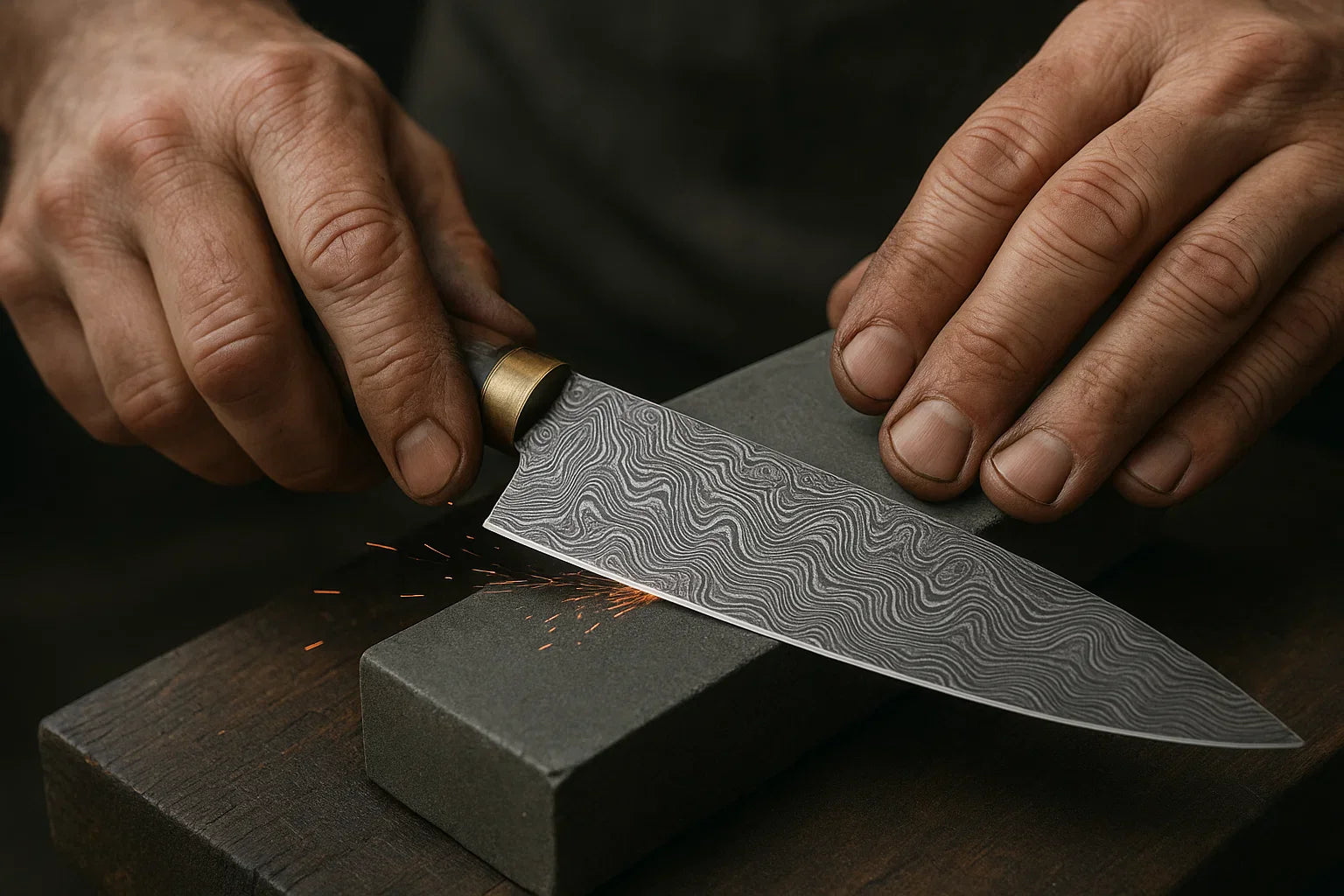Your Cart is Empty
FREE SHIPPING FOR USA

Damascus steel knives are known for their legendary sharpness, beautiful flowing patterns, and exceptional craftsmanship. Whether you’re using a Damascus chef knife in the kitchen or a folding knife in the outdoors, regular sharpening is essential to keep your blade performing at its best.
In this comprehensive guide, we’ll walkthrough how to sharpen a Damascus knife properly, what tools to use, common mistakes to avoid, and how to preserve the integrity of the iconic Damascus pattern while restoring your edge.
Unlike mass-produced blades, Damascus knives are hand-forged using layers of high-carbon and stainless steels. These layers give the blade both beauty and functionality — but they also require care during sharpening to:
Maintain the fine edge
Protect the etching and layered patterns
Extend the blade’s lifespan
Prevent chipping or uneven wear
Sharpening improperly — using electric grinders, wrong angles, or cheap sharpeners — can destroy the visual appeal and structural integrity of your Damascus knife.
To preserve the artistry of your Damascus steel, use tools that offer precision, control, and minimal abrasion:
1000 grit: Medium — for general edge restoration
3000–6000 grit: Fine — for refining sharpness
8000+ grit: Polishing — for razor-sharp edges
Used for final polishing and burr removal
Apply stropping compound for best results
Helps beginners maintain consistent sharpening angles
Use water for waterstones; oil for oilstones
If you're using a waterstone, submerge it in water for 10–15 minutes until bubbles stop appearing. Oil stones don’t need soaking but should be coated with honing oil.
Most Damascus kitchen knives should be sharpened at a 15–20° angle. For outdoor or thicker blades, a 20–25° angle is more durable.
Use a consistent angle to avoid uneven wear on the blade and distortion of the Damascus layers.
Place the knife on the stone at the chosen angle.
Starting from the heel to the tip, draw the blade across the stone in a sweeping motion, as if slicing a thin layer off.
Apply gentle, even pressure.
Repeat 10–15 strokes per side, depending on dullness.
Move to a higher-grit stone (3000–8000) to refine and polish the edge. Use the same motion and angle, applying lighter pressure.
Stropping removes the burr (microscopic edge distortion) and aligns the edge.
Pull the blade backward along a leather strop, alternating sides.
Use a green stropping compound for extra polish.
Many worry that sharpening will damage the beautiful wavy pattern of Damascus steel. Here's how to protect the etching:
Use whetstones only (avoid electric or belt grinders).
Don’t over-sharpen — remove only what is necessary.
After sharpening, re-etch with ferric chloride (only if needed and if you're experienced).
Clean with a soft cloth — avoid abrasives that can fade the etched design.
❌ Using pull-through sharpeners – These are too aggressive and can damage the pattern and the edge.
❌ Sharpening at the wrong angle – Can dull or roll the edge.
❌ Skipping grit levels – Jumping from coarse to fine grit leaves the edge rough and unfinished.
❌ Not stropping – Leads to burrs and shorter edge life.
❌ Using electric grinders – The heat and pressure can ruin Damascus layering and edge retention.
Light daily use: Hone with a strop weekly; sharpen every 2–3 months
Heavy kitchen use: Sharpen every 4–6 weeks
Outdoor use: Sharpen after any heavy-duty task or visible dulling
After sharpening:
Wipe the blade clean of any metal residue
Apply a thin coat of food-grade oil (e.g., camellia or mineral oil)
Store in a dry knife block, leather sheath, or magnetic strip
This prevents oxidation and keeps your blade in showroom condition.
Sharpening a Damascus steel knife is not just about restoring the edge — it’s about respecting the craftsmanship behind every blade. With proper sharpening techniques using whetstones, maintaining a consistent angle, and preserving the etching, your knife will remain a precision tool and a work of art for generations.
At Jun Knives, we take pride in crafting Damascus blades designed to last a lifetime — and with sharpening done right, they truly can.